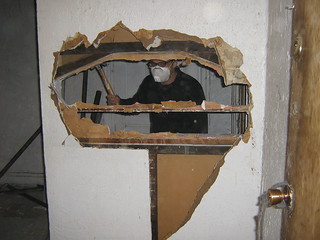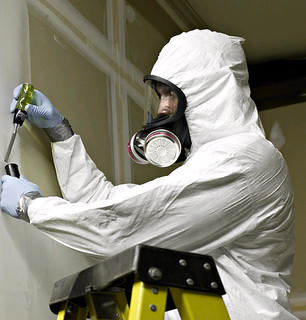Do It Yourself, Safely: Removing Walls
MySafetySign applauds the do-it-yourself spirit of home renovations, but there are often the same hazards in your weekend fixer-upper as there are on professional construction jobs. We want to make sure your project ends with a satisfied feeling of accomplishment, not a visit to the emergency room. Follow along as we cover the basics of home DIY in our series: Do It Yourself, Safely.
We’ve all seen DIY reality shows that feature sledgehammer-wielding homeowners demolishing walls with elated abandon. It seems so empowering, invigorating. And it makes for great TV.
The more-somber reality is that whether you’re removing walls or cutting an opening for a new window, you can’t be 100 percent certain what you’ll find – and potentially disturb – behind those walls.
But a little pre-sledgehammer planning can go a long way in protecting your health and safety, as well as your budget. Here are a few potential risk factors, and how to find out what you’re getting into before you make that first careful cut.
What can go wrong?
Structural instability: Load-bearing walls bear part of the structural load of your home. So removing one can literally leave your home unsupported, causing damage such as sinking floors and cracked walls, and presenting a real risk for collapse.
Electrical shock: Load-bearing walls are also popular places for routing electrical lines. And unfortunately, mis-wiring is common in many older and remodeled homes, which means that even if you kill power to the space before you begin cutting into a wall, you can be at risk of hitting a live wire.
Lead dust exposure: If your home was built before 1978, it most likely contains lead-based paint, according to the Environmental Protection Agency (EPA). Even if there are layers of newer paint on top, cutting into a wall can release lead dust, which has been linked to cardiovascular and neurological deficits.
Asbestos exposure: Tearing down a wall could also disturb asbestos. According to the U.S. Consumer Product Safety Commission (CPSC), asbestos can be found in the insulation of houses built between 1930 and 1950, in textured paint and patching compounds in homes built before 1977 and in cement sheet, millboard and paper once used as insulation in walls around wood-burning stoves. Cutting into these materials can release airborne asbestos fibers, which increase the risk of developing lung cancer if inhaled, according to the EPA.
Biologic pollutant exposure: Wood, wallboard and insulation all contain nutrients that allow biological pollutants like mold to grow. Like asbestos, mold sometimes doesn’t pose health threats until the material is disturbed.
Best Practices
- Check the structure: An inspector can check for electrical, plumbing, mechanical and structural issues, and can fill you in on the specifics of temporary supports and permanent structural supports that might be needed.
- Check the walls: Look for stains on the walls or rotting material, which can indicate water damage and the potential of mold.
- Get it sampled: In homes built before 1978, the Environmental Protection Agency recommends hiring a certified lead inspector to check for lead-based paint before you begin remodeling. If lead is present, the EPA offers an expansive list of specific recommendations to protect your health and prevent lead dust from spreading to other areas of the home.
If you live in an older home that may contain asbestos, the EPA also recommends hiring a professional to sample and analyze materials that will be disturbed during demolition and construction. If asbestos is detected, check with local health or building officials to find out the proper handling and disposal procedures, and if removal by a professional is required. The CPSC also recommends hiring different contractors to perform the testing and the removal, in order to avoid a potentially costly conflict of interest.
Further Resources
http://www.diynetwork.com/how-to/how-to-demolish-a-wall/index.html
https://homeguides.sfgate.com/wall-weightbearing-wall-32285.html
http://www.diynetwork.com/windows-walls-and-doors/drywall-tools-and-prep/index.html
Category: DIY Safety













